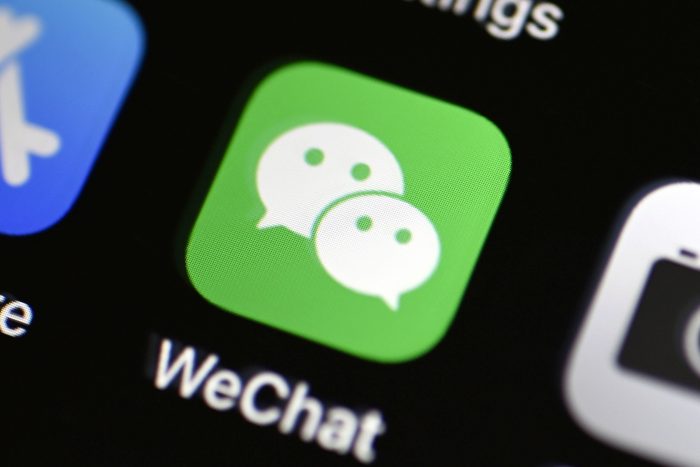
Last week, in response to Australia’s proposed media bargaining code, Facebook effectively halted all posting of links from Australian news pages and stopped people in Australia from posting or viewing international news as well.
The change, which has sent publishers’ traffic tumbling, happened overnight, and may be undone if either Australia or Facebook backs down. But if the current situation continues, it may leave Facebook operating much more like the Chinese platform WeChat, where news is ruled by platform-specific content houses cranking out huge volumes of low-quality articles. And that might suit Facebook quite well — if not the public.
WeChat is the major social media platform in the People’s Republic of China. It’s also used by many people around the world, including in Australia. While China and Australia have very different political systems, this shouldn’t stop us paying attention to their similarities.
WeChat is as privately owned as a company can be in China, and is often described as the Chinese Facebook. But WeChat is an even more pervasive platform, combining its own set of built-in tools, payment services, and communications networks with a range of optional apps and utilities, from messaging services to games and more.
In short, WeChat does everything. Because of this, entire news organizations have set up inside the platform. These are known as WeChat Official Accounts (WOAs), and are roughly equivalent to “blue tick” accounts on other platforms such as Twitter.
If Facebook’s Australian news embargo continues, we think something like the WeChat model might develop there. In our research, we have shown it’s very common for features and interface elements to move between English and Mandarin digital media.
People might have a general idea that some aspects of U.S.-based social media have been reproduced by Mandarin language services (such as WeChat’s Instagram-copying “Moments” product), but the copying goes both ways. The stickers, GIFs, QR codes, live commenting, and direct messaging used by the likes of Faceboook, Twitter and LinkedIn were copied from WeChat, Weibo and Bilibili.
Countless media entrepreneurs have set up WOAs since they were launched in August 2013. These accounts produce millions of news posts every day, and unlike traditional media outlets posting on Facebook, these posts are not accompanied by external links to a version of the article hosted elsewhere. WeChat is their whole audience, and they make money by renting out advertising space within their articles.
One of us (Fan Yang) conducted research with 24 Australian-Chinese employees of WOAs. These organizations appear to employ far fewer journalists than traditional media — and sometimes none at all. There are already many Australian-run WOAs operating almost entirely with short-term interns, most of whom do not identify themselves as professional journalists. Instead they are content producers translating published English news into Mandarin and reappropriating stories with editorial spin.
These organizations largely rehash existing news content, often with clickbait headlines and exaggerated accounts of events. Stories are often aggregated from multiple news sources, or simply copied entirely, perhaps being passed through an automated translation service twice to avoid directly reproducing sentences.
If we were to see the development of platform-specific Facebook news services modeled on the WeChat system, only a handful of media workers would be needed. They would perform multiple roles as writers, editors, marketers, content producers, and translators.
As these jobs might only require marginal professional experience in a specific field (such as politics, lifestyle, sports, or nature and environment), the work could be outsourced to places or regions where the labor cost is lower.
With the shrinking readership and advertising revenue in the traditional news industry, content farms and outsourced journalism have already become a common way to churn out a high volume of speedy and inexpensive content. Many fringe groups already operate this way on Facebook, run by anti-vaxxers, flat-Earthers, white supremacists and more. In the absence of more traditional news on Facebook, there is no reason this model couldn’t spread further.
When comparing China and Australia, we often think of divisions such as China’s shutdown of the “foreign” internet since 2009 and the current diplomatic and trade tensions. However, both nations have seen similar shifts in the way that information is controlled on their dominant platforms, and both have high levels of media concentration.
Whether the changes to Facebook will lead to increased levels of WeChat-style platform-specific news production houses, or an increased visibility of those that already exist, remains to be seen. This may depend on how independent and startup media find a way forward, although we believe the WeChat model may be successful for some.
We would suggest, however, that there are already two key messages to take away from the current situation. The first is to note that while regulation of social media is possible, political will is largely absent without the support of incumbent media organizations. This can be seen in the deals Google has recently established with several media companies.
Also, only Google and Facebook have been the focus of the media bargaining code so far. Can we expect regulation of Reddit, Discord, TikTok, WeChat, Twitter, or even MySpace and Ello? What about news platforms that link to other news platforms? These developments have not yet played out.
The second is that Facebook will defend its capacity to operate on its own terms, and will fight hard to prevent either states or competitors dictating how its services operate or how it governs content. Despite Facebook refusing to accept journalistic outlets as formal competitors (as this would likely invoke various national oversight mechanisms for journalistic content), they are nonetheless in competition for audiences and advertising.
Anything that could shift people into Facebook-specific news-advertising contexts with independent editorial teams would be a highly desirable outcome for the platform.
Fan Yang is a Ph.D student at Deakin University in Australia. Robbie Fordyce is a lecturer in communications and media studies at Monash University in Australia. This article is republished from The Conversation under a Creative Commons license.![]()